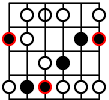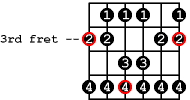Major Scale Shapes
CAGED System
The major scale is the foundation of a learning the neck of the guitar. There are a few different ways of organizing the major scale on the neck, but by far the most common and easiest to visualize is the CAGED Scale System. These scale forms are based around the basic open position major chords C, A, G, E and D. By using these chords shapes, you will be able to keep track of the different scale forms.
 |
 |
 |
 |
 |
Make sure that you learn how major scales are constructed. Understanding the theory, as well as learning the physical shapes will help you put these into use much sooner
For the purposes of demonstration, the examples will be for a G major scale. All of the notes that are circled in red are the root of the scale/chord (G)
E form
|
G major scale, based around the E chord form
|
This is the most common fingering for a major scale. It is usually the first one that is learned by most guitar players. In order to train your ear to hear the notes in relationship to the root, it is a good idea as part of your practice routine to hold the root note a little longer that the other notes. |
G |
This is a movable major chord shape, based on an open E. Played at the 3rd fret this is a G chord. Keep in mind that there is a difference between being based on a particular chord shape, and the actual chord sound. |
 |
This scale form is built around this movable major chord shape, and is sometimes referred to as the E form (CAG E D)of the major scale. It is not an E major scale, It is a G major scale based around the basic E major chord shape. |


